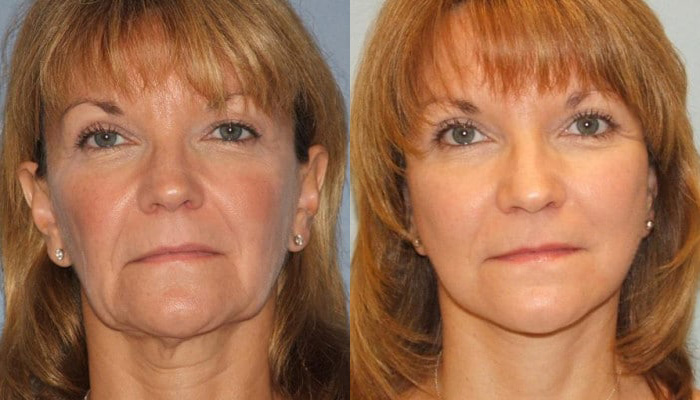
Facelift in Raleigh, NC
Some of the most common signs of aging include skin laxity (sagging or loose skin) and the presence of wrinkles and fine lines on the face. These facial skin changes can cause women and men to feel self-conscious about looking older than they actually are, and often older than they feel. Facelift surgery can help patients achieve a more balanced, healthy, and energetic appearance.
Facelift surgery is one of the most popular cosmetic surgeries available among women and men today and is designed to reverse signs of facial aging.
Facelift surgery involves tightening the facial and neck tissues and removing excess fat and skin.
Why Should I Choose Specialists in Plastic Surgery for My Facelift?
You can trust Raleigh’s Specialists in Plastic Surgery to give you the quality cosmetic results that you’ve been looking for. By choosing to have your facelift performed by Specialists in Plastic Surgery, you can be assured that you’ll be in the best of hands.
Our board-certified plastic surgeons have over 75 years of combined experience in cosmetic plastic surgery and are often referred to by other doctors and physicians in Raleigh.
Is Facelift Surgery Right for Me?
Ideal candidates for a facelift are patients in good overall health but are dissatisfied or self-conscious about their visible signs of facial aging.
Candidates should be non-smokers and have realistic expectations about their results. At your consultation, one of our board-certified plastic surgery specialists will evaluate your condition and let you know if facelift surgery is right for you.


Before & After Photo Gallery
Photo GalleryWhat Are the Benefits of Facelift Surgery?
The benefits of facelift surgery are both physical and psychological. A facelift can give you smoother facial skin along with a more contoured and defined lower face, and patients who undergo facelift surgery will hopefully feel more confident and comfortable with their appearance.
Facelift surgery can:
- Lift sagging facial tissues (such as midface/cheek tissues)
- Minimize the appearance of fine lines, wrinkles, and deep creases
- Create smoother, more youthful-looking lines
- Reduce the appearance of jowls
- Be extended to address laxity and vertical banding in the neck area
- Be combined with facial fat grafting or dermal fillers to restore facial volume
- Highlight your feminine or masculine facial definition
How Is Facelift Surgery Performed?
Facelift surgery is performed under general anesthetic or intravenous sedation. After the anesthesia has been administered, an incision is made starting at the temples and moving down around the ears, extending down to the lower scalp.
Through these incisions, the tissue and muscle are repositioned to smooth away any wrinkles and fine lines. Excess fat and tissue is then removed. If necessary, liposuction may be used to remove any subcutaneous fat in the area to give your face a sleeker, more contoured appearance.
The deep layers of tissue are secured in place with internal sutures, and the skin is tightened.
Excess skin is trimmed away, and the incisions are closed using fine sutures. Bandages are applied to the treatment area, and temporary drainage tubes may be inserted to allow excess fluid to drain from the incisions.
After Your Facelift
Immediately following surgery, you will experience some swelling, bruising, and discomfort. These temporary side effects are normal, and can be managed with prescription pain medication. Elevation of the area and ice packs may be used to minimize swelling.
Stitches are removed in about a week; bruising should resolve in the first two weeks, and swelling in three to eight weeks.
For most patients, normal activity may be resumed in one to two weeks, and more intense activity in six to eight weeks.
How Should I Prepare for My Facelift?
Patients who smoke must quit at least six weeks before their surgery. Smoking can inhibit oxygenated blood from circulating well, which will slow down healing. Surgical risks are also significantly higher for patients who smoke.
Nutrition and hydration are essential to prepare the body for surgery. Patients are encouraged to drink at least 64 ounces of water a day and consume fresh, whole foods with vitamins, minerals, and antioxidants.
It is necessary to arrange one to two weeks off from work, childcare, and home duties. Patients also need to arrange for someone to drive them home after their surgery and remain with them for 24 hours or more.
Prescription medication and other recommended supplies should be picked up before the day of surgery.
What Will My Recovery Be Like?
You will experience some tenderness, swelling, and bruising in the surgical areas. These side effects should mostly dissipate within the first two to three weeks. Any pain you experience can be alleviated with medication.
It is important that you rest your body while you recover. This means that you should not lift anything of weight or engage in any strenuous activities for two to four weeks.
After your procedure, your plastic surgeon will evaluate your recovery and clear you for normal, daily activities.
Are there any risks associated with facelift surgery?
A facelift, like any surgical procedure, has some degree of risk and uncertainty. Potential adverse events could include:
- Unsatisfactory cosmetic results
- Infection
- Pain
- Scarring
- Changes in facial sensitivity
What Results Can I Expect?
The general improvements achieved with facelift surgery can be noticed right away. For the first few weeks, however, your results may be obscured by swelling and bruising. After two weeks of healing, the new, lifted facial contours become more evident. It is at that time when patients can appreciate their younger appearance.
Aren’t Ready for a Facelift?
While facelift surgery can produce some of the most stunning transformations and can correct most age-related signs and symptoms in the mid and lower face, it may not be necessary for your concerns. Additionally, not every patient is willing or able to undergo an invasive surgical procedure.
If you are not ready to take the plunge, facelift alternatives are available for qualifying candidates. Non-surgical procedures and injectables can help reduce fine lines or wrinkles and increase facial volume to help you look more youthful.
Injectable treatments significantly help to reduce the appearance of lines and wrinkles by either blocking muscle contractions responsible for the wrinkles (BOTOX® Cosmetic, XEOMIN®, or Dysport®) or filling the hollow areas beneath the skin (dermal fillers). Fillers can also be used to add volume to the lips, cheeks, and other facial areas.
Non-surgical lifting techniques are available with the Silhouette InstaLift®. This is a type of thread lift that inserts threads beneath the skin to lift the deep skin layers and stimulate collagen.
Injectables and thread lifts can be performed alone or in combination with each other.
Have More Questions About Facelift Surgery?
-
Because facelift surgery is performed under anesthesia, you will not feel any pain or discomfort during your procedure. However, many patients experience pain and soreness after their procedure.
While comfort is managed with prescription pain medication, other postoperative side effects can be handled by resting and sleeping in a reclined position rather than lying flat. In terms of comfort, most patients feel well enough to go back to work and light activities in five to 10 days.
-
The results of a facelift are permanent in that the face looks younger than it would otherwise. That said, it usually takes 10 or more years for the signs of aging to begin to reappear after a facelift. How long results last can depend on several factors, including sun exposure, nutrition, even stress levels. Patients are encouraged to wear sunscreen and avoid tanning, to pursue a healthy lifestyle, and to avoid smoking.
-
Yes! Many patients choose to combine their facelift with other procedures and treatments. While giving you a more dynamic and complete facial rejuvenation, combining your facelift with other cosmetic procedures can lower the overall cost and recovery time, since you are having the procedures and recovering from them at the same time.
Some of the most commonly combined procedures and treatments with facelift surgery include:
-
Typically, patients who undergo facelift surgery do not need a second procedure. This is true regardless of patient age. Many facelifts are now performed on patients in their forties and fifties. To prolong the effects of this procedure, it can be beneficial to maintain a regular “beauty schedule” that addresses the ongoing loss of collagen and elastin in the skin. Treatments like injectables, chemical peels, and microneedling are all beneficial for the adult who wants to stay ahead of their aging process.
-
At your consultation, our patient care coordinators will provide you with a detailed individual estimate given your surgeon’s recommendations. Please schedule a consultation if you would like a generalized price estimate.
-
Depending on the extent of the surgery, a facelift can take anywhere from two to five hours to complete; however, you should expect to be at the surgery center for an extra hour or two to allow time for the anesthesia to be administered before the procedure and for it to wear off after the surgery.
-
It is not unusual for the face to look and feel tight after a facelift. However, we do not expect this to last long. Patients should take their time in choosing an experienced, board-certified plastic surgeon with a strong before and after gallery related to facelift procedures.
Our surgeons use precise facelift techniques aimed to achieve the ideal amount of tissue tightening and repositioning for naturally rejuvenated results.
Schedule Your Facelift Consultation in Raleigh, NC
If you’re interested in learning more about facelift surgery or you want to schedule your consultation, please give us a call at (919) 785-0505 or use our online contact form here.
